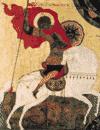- Novgorod school
-
Important school of Russian medieval icon and mural painting that flourished around Novgorod in the 12th–16th centuries.Novgorod, Russia's cultural centre in the 13th–14th centuries, when most of the rest of the country was occupied by the Mongols, preserved the Byzantine traditions that formed the basis of Russian art but introduced lighter and brighter colours, flatter forms, softening of facial types, and increasing use of a graceful, rhythmic line to define form. Until the early 14th century, artistic activity was dominated by mural painting. A new artistic impetus was provided by the introduction of the iconostasis. When icons were displayed together on the iconostasis rather than scattered about the walls of the church, they demanded a coherent overall impression, which was achieved by strong, rhythmic lines and colour harmonies. Figures took on the elongated shape that became standard in Russian art. In the 16th century artistic leadership passed to the Moscow school.
 "Miracle of St. George over the Dragon," icon by an anonymous artist of the Novgorod ...Novosti Press Agency
"Miracle of St. George over the Dragon," icon by an anonymous artist of the Novgorod ...Novosti Press Agency* * *
▪ artimportant school of Russian medieval icon and mural painting that flourished around the northwestern city of Novgorod from the 12th through the 16th century. A thriving merchant city, Novgorod was the cultural centre of Russia during the Mongol occupation of most of the rest of the country in the 13th and 14th centuries. During that period it preserved the Byzantine traditions that formed the basis of Russian art and at the same time fostered the development of a distinct and vital local style, a style which, though provincial, contained most of the elements of the national Russian art that eventually developed in Moscow in the 16th century.The first important phase of the Novgorod school lasted through the 12th century and the first half of the 13th, a period during which the Byzantine tradition spread from southern Kiev, the first capital and cultural centre of Russia, to the northern centres of Novgorod and Vladimir-Suzdal. In this period fresco painting was the dominant art form. In the second half of the 12th century the hieratic, aristocratic artistic tradition of Kiev was abandoned in favour of a more informal approach that combined Byzantine severity of style with a tenderness of gesture and an anecdotal picturesqueness. This spirit was matched in the beginning of the 13th century by a shift toward lighter, brighter colours and flatter forms, a softening of facial types, and an increasing definition of form by means of a graceful, rhythmic line. The progressive importance of line over modeled form in Novgorod painting brought about a gradual change in the Byzantine image. Strongly modeled Byzantine figures were characterized by a direct and penetrating gaze that in turn engaged that of the viewer. But as the predominance of line flattened the figures and faces in Novgorod painting, the direct gaze receded into a dreamy, abstracted, introspective look. In addition, the line invited a contemplation of its abstract patterns; Novgorod painting began to emphasize the lyricism of these patterns rather than the immediate presence of the figures.In the early 14th century, a new artistic impetus was provided by the introduction of the iconostasis, a screen standing before the sanctuary on which icons, formerly scattered over the walls of the church, could be hung in a prescribed arrangement. The stylistic tendencies of the previous period of artistic activity, which had been dominated by fresco painting, were brought to bear on the visual problems created by the iconostasis and coalesced into a definitive Novgorod style. The complex of paintings on the iconostasis demanded a coherent overall impression. This overall effect was achieved through the use of strong, rhythmic lines and colour harmonies in each icon. Novgorod painters used jewellike juxtapositions of brilliant yet delicately balanced colours, dominated by yellow, emerald green, and fiery vermilion. The silhouette became all-important, as did the line, which assumed unprecedented grace with an elongation of the figure that became standard in Russian art. A number of Greek artists who arrived from Constantinople at the end of the 14th century brought a more varied subject matter to the Novgorod school and introduced the use of more complex architectural backgrounds. The most influential of these Byzantine immigrants was a mural painter, Theophanes The Greek. Theophanes contributed a greater understanding of the human form and a subtler use of colour and design to later Novgorod painting.At the end of the 15th century Novgorod painting became somewhat repetitive, and, although works of outstanding quality continued to be produced, they lacked the freshness of the earlier paintings. The leadership in Russian painting passed in the 16th century to the more cosmopolitan art of the Moscow school (q.v.), and the final dissolution of the Novgorod school came with the forcible transfer of Novgorod artists to Moscow after a fire in the capital in 1547.* * *
Universalium. 2010.
